How To Open Incognito Window
How to go incognito in Chrome, Border, Firefox, and Safari
While incognito mode in whatsoever of the large four spider web browsers offers a measure of privacy, it doesn't completely hide your tracks online. Hither'southward how the feature works in each browser, and how to utilise it.

- How to privately browse in Microsoft Edge
- How to do private browsing in Mozilla Firefox
- How to browse privately using Apple'south Safari
Show More than
Private browsing. Incognito. Privacy mode.
Spider web browser functions like those trace their roots back more than than a decade, and the feature — starting time establish in a top browser in 2005 — spread quickly equally one copied another, made tweaks and minor improvements.
But privacy-promising labels can be treacherous. Simply put, going "incognito" is as effective in guarding online privacy as witchcraft is in warding off a common cold.
That's considering private browsing is intended to wipe local traces of where you've been, what yous've searched for, the contents of forms you've filled. It'due south meant to hide, and non always conclusively at that, your tracks from others with admission to the personal computer. That's it.
At their most basic, these features promise that they won't record visited sites to the browsing history, save cookies that show you've been to and logged into sites, or remember credentials like passwords used during sessions. But your traipses through the web are nonetheless traceable past Net providers – and the authorities who serve subpoenas to those entities – employers who control the company network and advertisers who follow your every pace.
To finish that cerebral dissonance, almost browsers have added more than advanced privacy tools, generically known as "anti-trackers," which block diverse kinds of bite-sized chunks of code that advertisers and websites use to trace where people go in attempts to compile digital dossiers or serve targeted advertisements.
Although it might seem reasonable that a browser's end game would be to craft a organization that blends incognito modes with anti-tracking, it's highly unlikely. Using either private browsing or anti-tracking carries a price: site passwords aren't saved for the next visit or sites break nether the tracker scrubbing. Nor are those costs equal. It's much easier to turn on some level of anti-tracking past default than it would be to practice the aforementioned for private sessions, as evidenced by the number of browsers that exercise the former without complaint while none do the latter.
Private browsing will, by necessity, always be a niche, as long every bit sites rely on cookies for mundane things like log-ins and cart contents.
But the style remains a useful tool whenever the browser -- and the reckoner it's on -- are shared. To prove that, we've assembled instructions and insights on using the incognito features -- and anti-tracking tools -- offered by the superlative four browsers: Google Chrome, Microsoft's Chromium-based Edge, Mozilla's Firefox and Apple's Safari.
How to go incognito in Google Chrome
Although incognito may be a synonym to some users for whatsoever browser's individual mode, Google gets credit for grabbing the discussion equally the feature's snappiest name when it launched the tool in late 2008, just months afterward Chrome debuted.
The easiest fashion to open an Incognito window is with the keyboard shortcut combination Ctrl-Shift-N (Windows) or Control-Shift-N (macOS).
Another style is to click on the menu on the upper right - it'southward the three vertical dots - and select New Incognito Window from the list.
 Google
Google Open up a new Incognito window in Chrome using keyboard shortcuts or from the menu (1) by choosing New Incognito window (2).
The new Incognito window can exist recognized by the dark background and the stylized "spy" icon just to the left of the three-dots menu. Chrome also reminds users of just what Incognito does and doesn't do each fourth dimension a new window is opened. The message may become tiresome for regular Incognito users, but it may also save a task or reputation; information technology'south important that users remember Incognito doesn't foreclose ISPs, businesses, schools and organizations from knowing where customers, workers, students, and others went on the web or what they searched for.
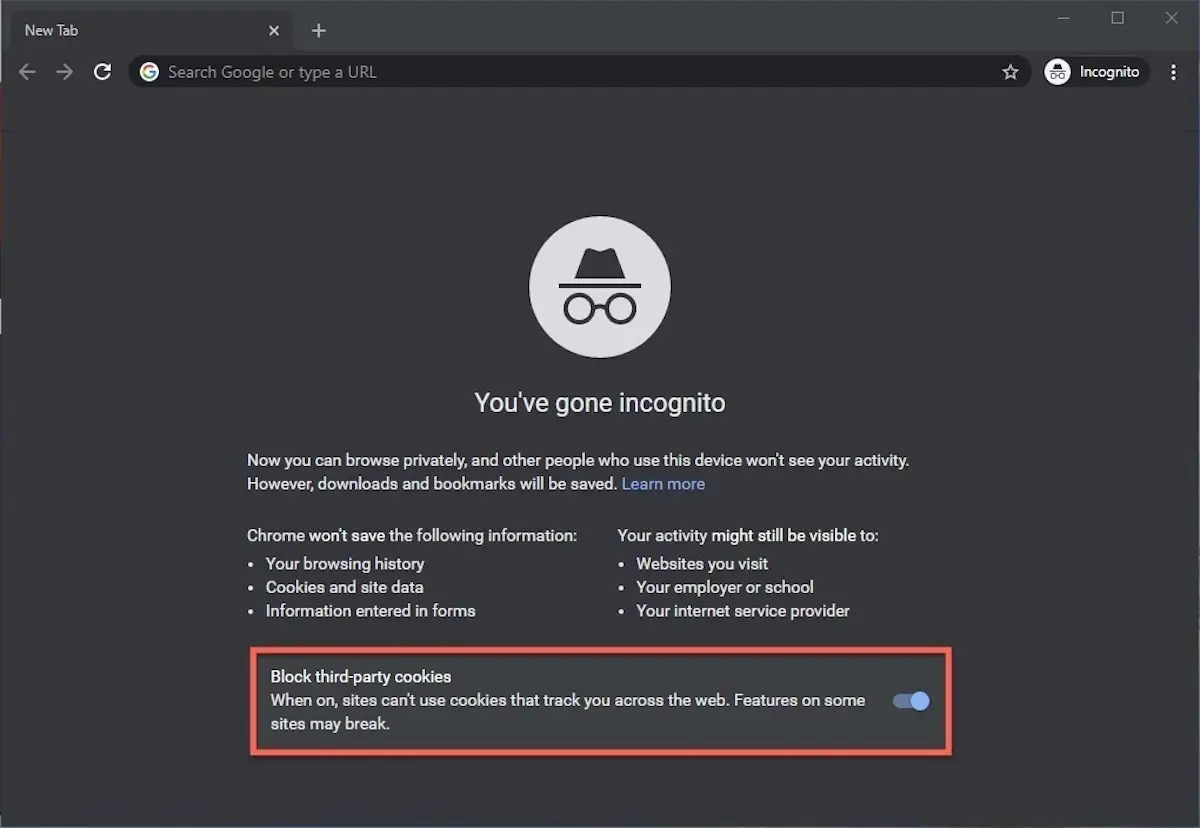 Google
Google Each fourth dimension a new Incognito window is opened, Chrome reminds users what Incognito doesn't relieve. As of Chrome 83, it as well puts a toggle on the screen for blocking 3rd-party cookies.
Incognito'southward introductory screen also displays a toggle -- it's on by default -- along with text that states third-party cookies volition exist blocked while in the privacy mode. Although cookies are never saved locally as long as the user stays in Incognito, websites have been able to rail user movements from site to site while within Incognito. Such tracking might exist used, for instance, to display ads to a user visiting multiple sites in Incognito. This third-party cookie blocking, which halts such behavior, debuted in Chrome 83 in May 2020.
Google has been experimenting with new language on Chrome's Incognito introductory folio, but information technology's still to make information technology to the desktop browser. In the Canary build of Chrome on Android, yet, the intro now outlines "What Incognito does" and "What Incognito doesn't do," to brand the style's capabilities somewhat clearer to the user. (Some have speculated that the changes were made in reaction to a even so-ongoing class-activity lawsuit file in 2020 that declared Google continued to track users' online behavior and movements in Incognito.)
One time a tab in Incognito has been filled with a website, Chrome continues to remind users that they're in Incognito by the nighttime background of the address bar and window title.
A link on an existing page can exist opened straight into Incognito by right-clicking the link, then choosing Open Link in Incognito Window from the resulting card.
 Google
Google What Incognito looks like subsequently pulling up a website. Note the "spy" icon at the right of the address bar.
To shut an Incognito window, shutter it like any other Chrome window by clicking the 10 in the upper correct corner (Windows) or the cerise dot in the upper left (macOS).
Pro tip: Google has been working on locking Incognito mode tabs on mobile devices -- the tabs unlocked with built-in biometric features -- so that others can't become a look at the privacy mode's content simply by picking upwardly some other's telephone or tablet. Google is currently rolling out this feature in Chrome 92 on iOS, and still testing it in preview builds of Chrome for Android. No word on whether desktop Chrome volition get something similar.
How to privately scan in Microsoft Border
borrowed the proper noun of its private browsing mode, InPrivate, from Internet Explorer (IE), the finally-being-retired legacy browser. InPrivate appeared in IE in March 2009, about iii months after Chrome'south Incognito and three months before Firefox'south privacy mode. When Edge was first released in 2015 then relaunched as a clone of Chrome in January 2020, InPrivate was office of the package, too.
At the keyboard, the combination of Ctrl-Shift-N (Windows) or Control-Shift-N (macOS) opens an InPrivate window.
A slower way to get at that place is to click on the menu at the upper right -- it's three dots arranged horizontally -- and choose New InPrivate Window from the menu.
 Microsoft
Microsoft Similar other browser, Edge volition take you incognito from the menu (1) when yous choice New InPrivate window (2).
Edge does a more thorough chore of explaining what its private browsing mode does and doesn't do than any of its rivals, with on-screen paragraphs dedicated to describing what information the browser collects in InPrivate and how the strictest additional anti-tracking setting can exist called on from within the mode. In addition, Border 92 -- the current version as of this writing -- uses the more than informal "What Incognito does" and "What Incognito doesn't do" language on its InPrivate introductory screen, something desktop Chrome hasn't nevertheless gotten to.
Microsoft's browser also well marks InPrivate when the mode is operating: a blue-colored oval marked "In Individual" to the correct of the accost bar combines with a full-black screen to brand sure users know where they're at.
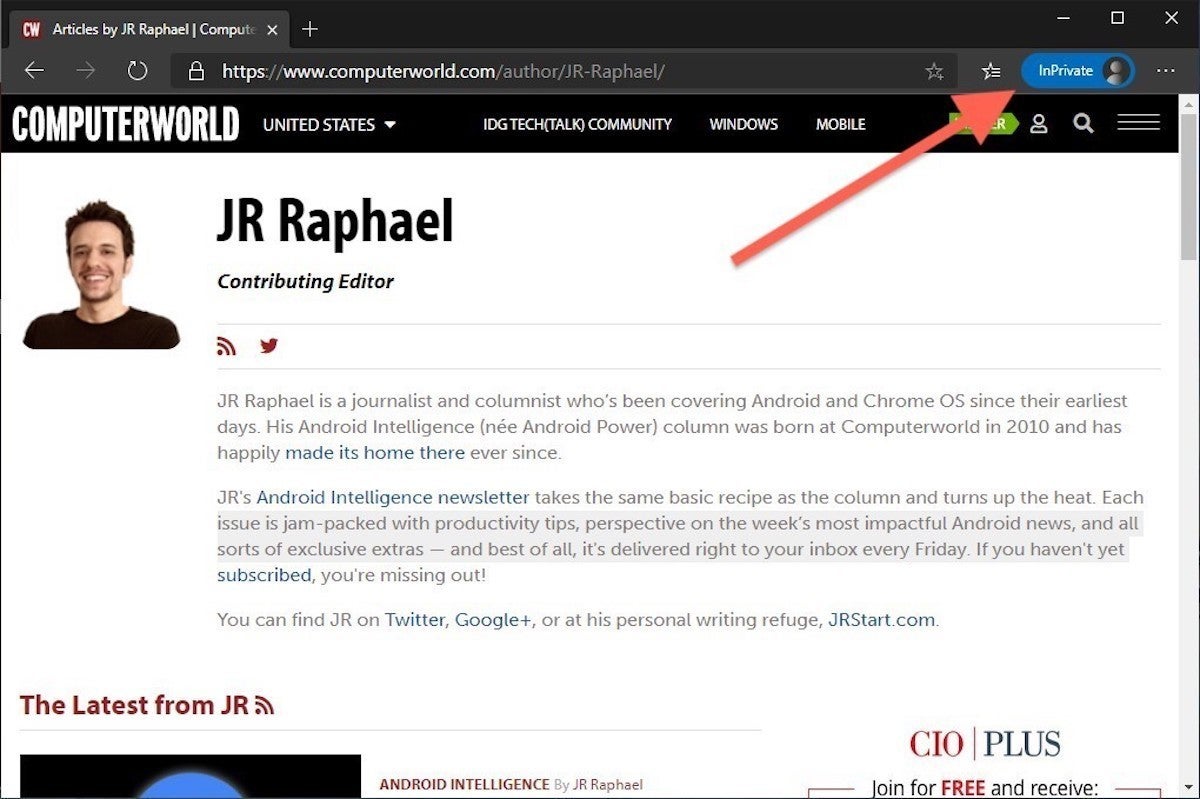 Microsoft
Microsoft The white-on-blue oval at the upper right tells you Border is in InPrivate mode.
It's too possible to launch an InPrivate session past right-clicking a link within Border and selecting Open in InPrivate Window. That option is grayed out when already in a private browsing session merely using Open Link in New Tab does but that within the current InPrivate frame.
To end InPrivate browsing, simply close the window by clicking the Ten in the upper right corner (Windows) or click the red dot at the upper left (macOS).
Although Microsoft based the relaunched Border on Chromium, the same open-source projection that comes upwardly with the code to power Chrome, the Redmond, Wash. company has integrated anti-tracking into its browser, something Chrome has nonetheless to practise. Dubbed "Tracking Prevention," it works both in Edge's standard and InPrivate modes.
To set Tracking Prevention, choose Settings from the three-ellipses bill of fare at the right, so at the next page, option Privacy, Search and Services. Choose one of the 3 options -- Basic, Counterbalanced or Strict -- and brand sure the toggle for Tracking prevention is in the "on" position. If y'all desire InPrivate to always default to the harshest anti-tracking -- not a bad idea -- toggle Ever utilize "Strict" tracking prevention when browsing InPrivate to "on."
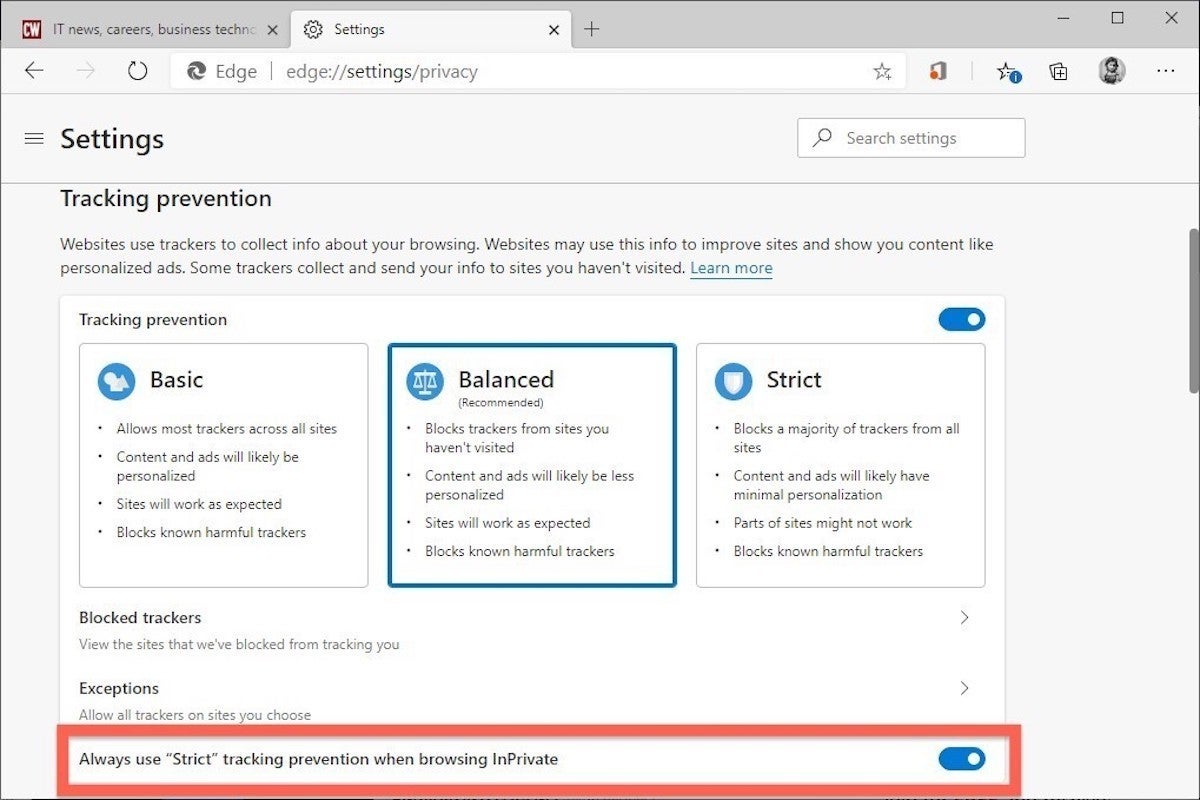 Microsoft
Microsoft Toggle Ever apply Strict to the 'on' position and InPrivate will apply the most stringent anti-tracking fifty-fifty though Edge's standard mode is set to, say, Balanced.
Pro tip: To open Edge with InPrivate -- rather than first opening Edge in standard fashion, and so launching InPrivate -- right-click the Edge icon in the Windows taskbar and select New InPrivate Window from the list. There is no similar one-step way to practise this in macOS.
How to do individual browsing in Mozilla Firefox
Afterwards Chrome trumpeted Incognito, browsers without something similar hustled to take hold of up. Mozilla added its take -- dubbed Private Browsing -- about six months afterwards Google, in June 2009, with Firefox 3.5.
From the keyboard, a private browsing session can be called up using the combination Ctrl-Shift-P (Windows) or Command-Shift-P (macOS).
Alternately, a individual window will open from the menu at the upper right of Firefox -- three short horizontal lines -- subsequently selecting New private window.
 Mozilla
Mozilla Opening a private browsing window is as elementary as choosing New Private Window (ii) from the Firefox carte (1).
A private session window is marked past the regal "mask" icon in the title bar of the Firefox frame. In Windows, the icon is to the left of the minimize/maximize/close buttons; on a Mac, the mask squats at the far correct of the title bar. Unlike Chrome and Edge, Firefox does non color-code the top components of the browser window to signify the user is in privacy mode.
Similar other browsers, Firefox warns users that individual browsing is no catholicon for privacy ills but is limited in what it blocks from beingness saved during a session. "While this doesn't make you bearding to websites or your internet service provider, it makes information technology easier to keep what yous exercise online private from anyone else who uses this computer," the circumspection reads.
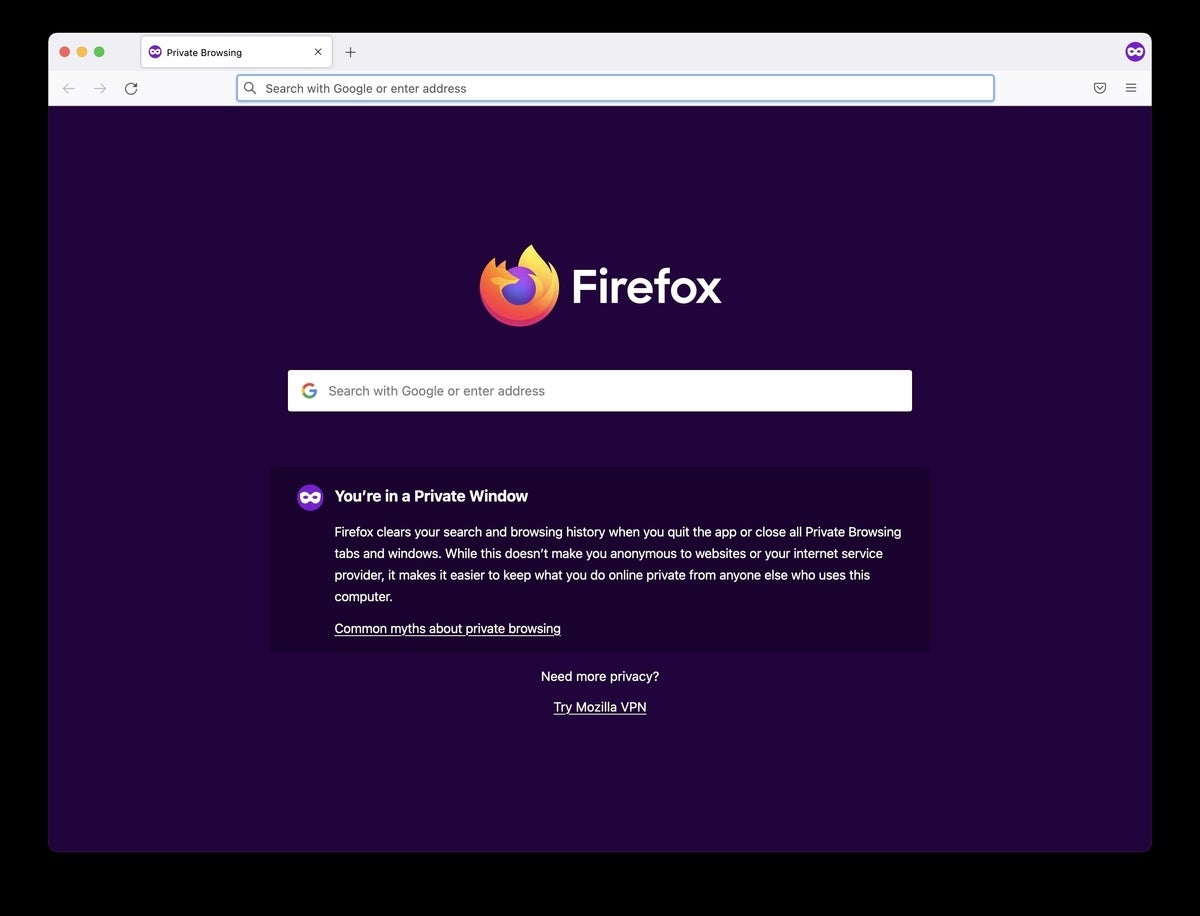 Mozilla
Mozilla Firefox reminds users that while a private session doesn't save searches or browsing histories, it doesn't cloak them in complete anonymity.
(Firefox also uses the Private Browsing introductory screen to shill the Mozilla VPN service, a $five to $ten per month virtual private network that can, like other VPNs, hide your actual IP address from destination servers.)
A link can be opened into a Firefox Private Window by right-clicking the link, then choosing Open Link in New Individual Window from the carte du jour.
To close a Private Window, shut it down but as one would any Firefox window by clicking the X in the upper right corner (Windows) or the ruby dot in the upper left (macOS).
Notable is that Firefox's private browsing mode is accompanied by the browser'southward superb "Enhanced Tracking Protection," a suite of tracker blocking tools that stymie all sorts of advertizing-and-site methods for identifying users, and so watching and recording their online behavior. While the earliest version of this was offered simply inside Private Windows, the expanded technologies also work within standard manner.
Considering Enhanced Tracking Protection is enabled by default within Firefox, it doesn't affair which of its settings -- Standard, Strict or Custom -- is selected as far as private browsing goes; everything that tin be blocked will be blocked.
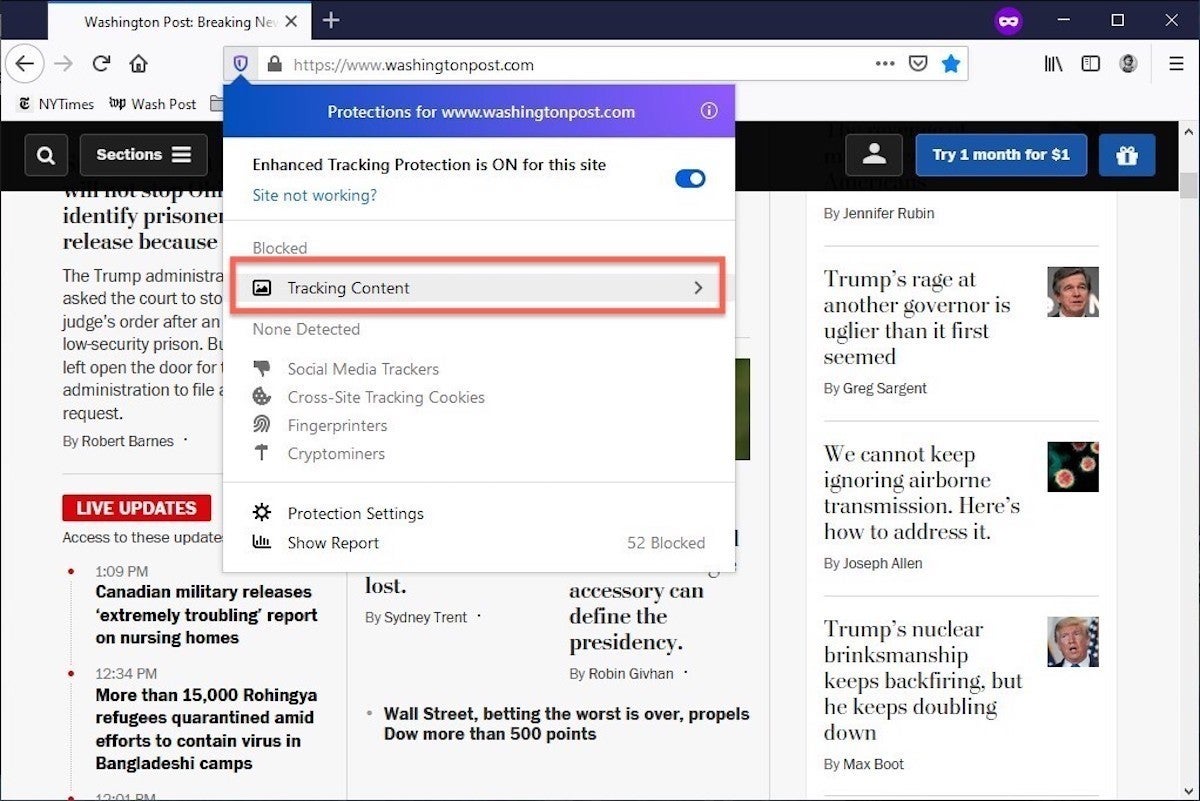 Mozilla
Mozilla The shield appears in the address bar to note what trackers were blocked by Firefox in a Private Window. Clicking on the icon brings up an accounting of what was barred.
Pro tip: As of Firefox 91, Private Browsing sessions take place over the more than secure HTTPS, not the one time-standard HTTP protocol. Users don't need to do annihilation: The new HTTPS-only policy is on by default. (If the destination site doesn't support HTPPS, Firefox will recognize this and go into fallback mode, connecting via HTTP instead.)
How to browse privately using Apple'due south Safari
Chrome may get far more attention for its Incognito than any other browser -- no surprise, since it's by far the near popular browser on the planet -- just Apple's Safari was actually the first to introduce private browsing. The term private browsing was offset bandied in 2005 to describe Safari 2.0 features that limited what was saved past the browser.
How To Open Incognito Window,
Source: https://www.computerworld.com/article/3356840/how-to-go-incognito-in-chrome-firefox-safari-and-edge.html
Posted by: barnestheregoth.blogspot.com


0 Response to "How To Open Incognito Window"
Post a Comment